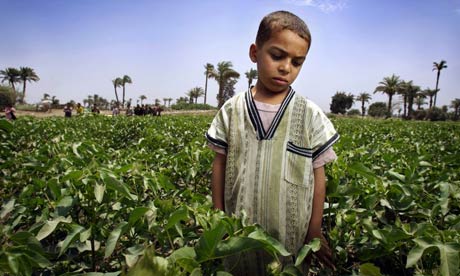 War in the Land of Egypt by Yusuf Al Qa'Id is a fascinating novel told from the perspectives of six different characters examining social inequality in rural Egypt. Published in 1973, it was banned in Egypt until 1985 — before being made into a film El-Mawatan Masri starring Omar Al-Sharif. The name of the main character (the only character who has a name, in fact) is "Masri," a name that means "Egyptian." ("Feddan Masri" is a unit of land measurement about equal to one acre.) "Fellahin" is the name for Egyptian farmers,
War in the Land of Egypt by Yusuf Al Qa'Id is a fascinating novel told from the perspectives of six different characters examining social inequality in rural Egypt. Published in 1973, it was banned in Egypt until 1985 — before being made into a film El-Mawatan Masri starring Omar Al-Sharif. The name of the main character (the only character who has a name, in fact) is "Masri," a name that means "Egyptian." ("Feddan Masri" is a unit of land measurement about equal to one acre.) "Fellahin" is the name for Egyptian farmers, Comprising 60% of the Egyptian population, the fellahin lead humble lives and continue to live in mud-brick houses like their ancient ancestors. Their percentage was much higher in the early 20th century, before the large influx of Egyptian fellahin into urban towns and cities.Rural poverty is an important fact of contemporary life in Egypt,
Although the incidence of poverty is decreasing overall in Egypt, the number of poor people continues to increase as the population grows. Egypt has about 10.7 million poor people, and 70 per cent of them live in rural areas. Most of the country's rural poor people live in the north, in Upper Egypt, where there are higher rates of illiteracy and infant mortality, poorer access to safe water and sanitation, and larger numbers of underweight children.Tenant, small-scale and landless farmers are often not able to grow enough food to feed themselves, especially in the north of Egypt where plots are smaller. (Contrast with the self-supporting village described in Aunt Safiyya and the Monastery.)

Rural labor is exploitative as rich landlords owning vast tracts of land profit at the expense of the poor. "Whereas the shaykh al-balad was the traditional leader in village society, serving as the representative of the villagers against the state, the 'umda was responsible for village control under the direct supervision
of the state." (Kato)
Peasants pay landowners high rents for the right to work the fields. The gains made by landless peasants in the aftermath of the sweeping land reforms that followed the July 1952 Revolution were eroded when the late President Anwar El-Sadat first curtailed and then abolished the land reforms initiated by the late president Gamal Abdel-Nasser and which were in favour of landless peasants. Before the revolution rents averaged 75 per cent of the income of landowners. Today, the situation is approximating pre-revolution conditions in this respect. The cumulative effect of the population explosion and the indebtedness of landless peasants accentuates the quandary of child labourers in rural backwaters.The novel traces this reversal of land reforms enacted under Nasser and carried out by Sadat. In America foreign policy, of course, Nasser, who led land reform, was considered "an enemy" and Sadat, who ended it, a "friend." I wonder why?

5 comments:
Thank you, Dr. Webb, for all of the research you did... fascinating and sobering! This particular subject- Egypt- has always fascinated me.
I wish someone would compile a book of the counterintuitive and hypocritical actions the U.S. has taken (who we back, who we help to overthrow, to whom we give power, what information/global news is/isn't presented to us). Someone probably already has and I just don't know about it. I love my country, but I think that the existence/knowledge of such a compilation, seeing decades - centuries - of just plain wrongdoing would maybe usher in some new progressivists.
yet another example of short-sighted US foreign policy injuring large amounts of people. i have to agree with virgi-- do our leaders even think these things through?
i think that it is great that we have discussions in class. I think that it is also great how much information you look up to share with us. I know that this is going to sound bad but i also like how you put up these pictures bc its real and not fake or made up it scares us and shows us the reality of war how sad and horrible war can be. i look at these two pictures and think WHY> here is this little girl who has so much life and love and then the next pictures shows us her lifeless body. she did not even get to live her life. It makes you think and makes you enjoy your life and to not have any regrets. To live life!
Post a Comment